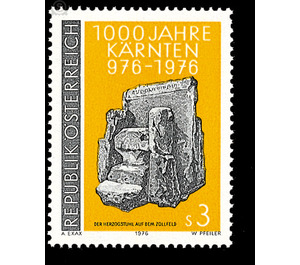1000 years - Austria / II. Republic of Austria 1976 - 3 Shilling
Theme: Devices, Items & Instruments
| Country | Austria / II. Republic of Austria |
| Issue Date | 1976 |
| Face Value | 3.00 |
| Color | yellow green |
| Printing Type | combination printing |
| Stamp Type | Commemorative |
| Item Type | Stamp |
| Chronological Issue Number | 854 |
| Chronological Chapter | OOS-OE2 |
| SID | 901068 |
| In 66 Wishlists | |
Carinthia entered the history as duchy of the German Reich in the year 976 in addition to the old tribal duchies of Bavaria, Swabia, Franconia and Saxony. After the uprising of the Bavarian Duke Henry the Prussian Karantanien was dissolved by Emperor Otto II from the existing since about 740 connection with Bavaria and delivered to Duke Henry from the luitpolding former Bavarian ducal family. At that time it also included today's Styria. According to the news that has been handed down since the beginning of the 14th century on customs duties in the customs field, the duke, who was entrusted by the German king to Carinthia, appeared in princely stone in Karnburg in rustic costume in front of the ducal peasant sitting on the stone. He subjected him to an examination of his Christian faith, his suitability as a lawyer and protector of the poor, widows and orphans. Hereupon the peasant cleared the stone from which the duke took possession. Then a solemn procession moved to the ducal chair, on whose east seat the sovereign took his seat, while the west seat was occupied by the Count of Gorizia as palatine of the country. The construction of the double throne of the ducal chair was likely to have fallen in the second half of the 9th century. As a symbol of the "independence and self-entitlement of the country Carinthia" the Herzogstuhl is to be regarded as one of the venerable legal monuments of Austria. The ducal chair can also be seen on the brand image.


